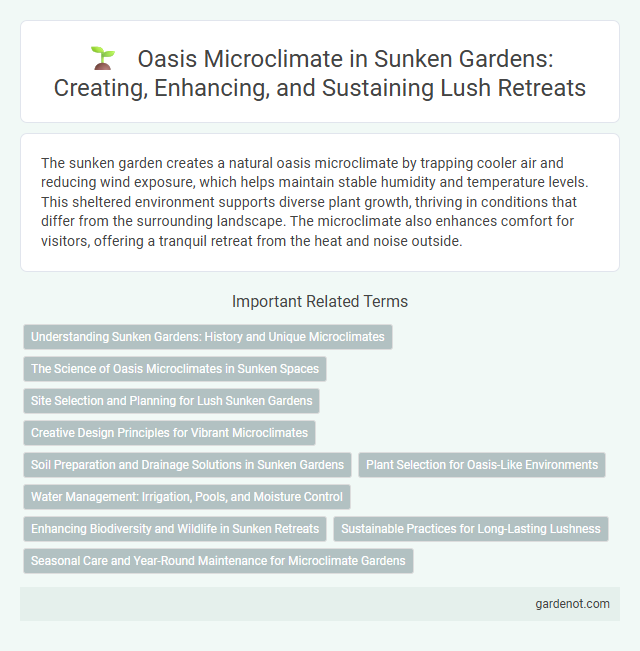The sunken garden creates a natural oasis microclimate by trapping cooler air and reducing wind exposure, which helps maintain stable humidity and temperature levels. This sheltered environment supports diverse plant growth, thriving in conditions that differ from the surrounding landscape. The microclimate also enhances comfort for visitors, offering a tranquil retreat from the heat and noise outside.
Understanding Sunken Gardens: History and Unique Microclimates
Sunken gardens create distinctive microclimates by sheltering plants from wind and extreme temperature fluctuations, fostering a humid, stable environment ideal for diverse flora. These designs, rooted in Renaissance and Victorian landscaping, often utilize natural depressions or man-made pits to harness thermal regulation and moisture retention. Understanding these microclimates is crucial for preserving plant health, optimizing growth, and maintaining the garden's historical and ecological balance.
The Science of Oasis Microclimates in Sunken Spaces
Sunken gardens create unique oasis microclimates by leveraging natural depression to trap cooler air and retain moisture, fostering a stable environment ideal for diverse plant life. The surrounding walls reduce wind speed and enhance humidity retention, which lowers temperature extremes compared to adjacent areas. This microclimate supports evapotranspiration processes, promoting plant health and contributing to localized cooling effects through increased shade and soil moisture.
Site Selection and Planning for Lush Sunken Gardens
Selecting a site with natural shelter from wind and ample sunlight is crucial for creating a lush sunken garden that fosters an oasis microclimate. Incorporating water features and dense vegetation enhances humidity and cools the area, promoting a thriving ecosystem. Strategic elevation adjustments and soil amendments optimize drainage and root health, ensuring sustained plant growth in the sunken garden environment.
Creative Design Principles for Vibrant Microclimates
Oasis microclimates within sunken gardens leverage creative design principles such as strategic plant layering, water features, and shaded terraces to foster vibrant, sustainable environments. Incorporating native flora enhances biodiversity while regulating temperature and humidity, creating natural cooling effects crucial for microclimate stability. Thoughtful spatial arrangement maximizes sunlight exposure and airflow, optimizing conditions for both plant health and visitor comfort in these enclosed green spaces.
Soil Preparation and Drainage Solutions in Sunken Gardens
Effective soil preparation in sunken gardens involves enhancing soil structure with organic matter to improve aeration and moisture retention, crucial for supporting the unique microclimate of these enclosed spaces. Strategic drainage solutions, such as installing French drains or layered gravel beds, prevent waterlogging and maintain optimal soil moisture levels, fostering healthy root systems in the often compacted or clay-heavy soils typical of sunken garden designs. Tailoring soil amendments and implementing efficient drainage ensures a balanced microclimate, promoting vibrant plant growth and sustainability in sunken garden environments.
Plant Selection for Oasis-Like Environments
Plant selection for oasis-like environments in sunken gardens prioritizes drought-tolerant species such as succulents, date palms, and native desert shrubs that thrive in microclimates with limited water availability. These plants adapt to intense sunlight and high temperatures while contributing to the garden's humidity regulation and soil stabilization. Integrating deep-rooted perennials and drought-resistant ground covers enhances water retention and supports a sustainable oasis microclimate within the sunken garden.
Water Management: Irrigation, Pools, and Moisture Control
The Sunken Garden's water management system integrates advanced irrigation techniques with strategically placed pools that enhance the Oasis microclimate by maintaining consistent soil moisture levels. Efficient drip irrigation minimizes water usage while promoting deep root hydration, supporting plant health in this enclosed environment. Evaporation from pools increases local humidity, aiding in moisture control and creating a cooler, more stable microclimate within the garden.
Enhancing Biodiversity and Wildlife in Sunken Retreats
Oasis microclimates in sunken gardens create unique, sheltered environments that support diverse plant and animal species by maintaining cooler temperatures and higher humidity levels. These conditions foster enhanced biodiversity, attracting pollinators, amphibians, and various insects critical for ecosystem health. Strategic planting of native flora combined with water features strengthens habitat complexity, encouraging wildlife to thrive within these secluded green retreats.
Sustainable Practices for Long-Lasting Lushness
The Sunken Garden's Oasis microclimate supports sustainable practices by maintaining consistent humidity and temperature levels that reduce water consumption and promote robust plant growth. Utilizing native plant species and organic mulch enhances soil health while minimizing the need for chemical fertilizers and pesticides. Efficient rainwater harvesting systems capture and recycle precipitation, ensuring long-lasting lushness and ecological balance in the garden.
Seasonal Care and Year-Round Maintenance for Microclimate Gardens
Sunken garden microclimates thrive with seasonal care practices such as mulching in autumn and strategic pruning in spring to regulate temperature and moisture levels. Year-round maintenance includes monitoring soil moisture, controlling pests organically, and ensuring adequate shading during peak summer months to sustain optimal microclimate conditions. These consistent efforts promote healthy plant growth and preserve the delicate balance of humidity and temperature unique to sunken garden environments.
Oasis microclimate Infographic

 gardenot.com
gardenot.com